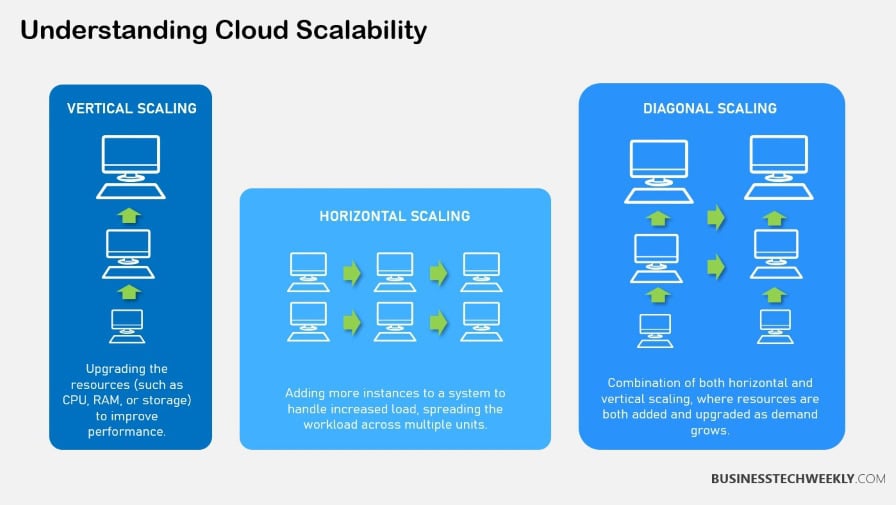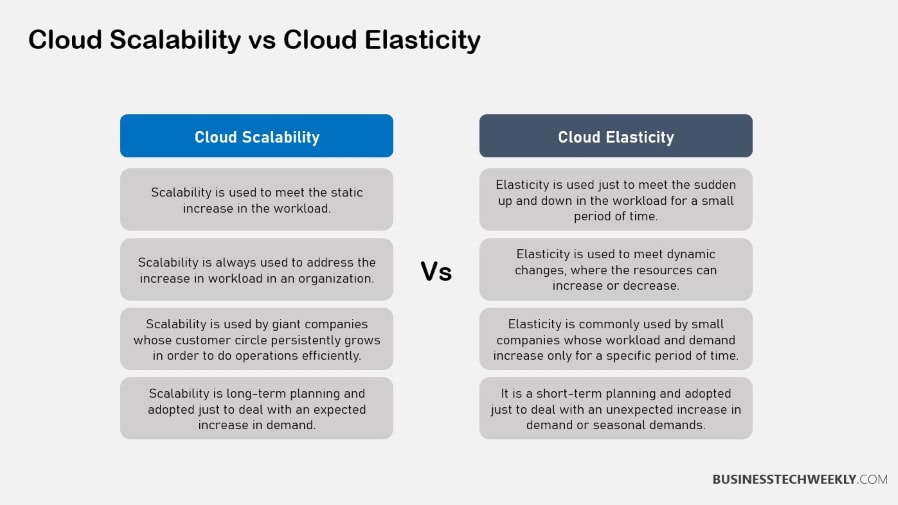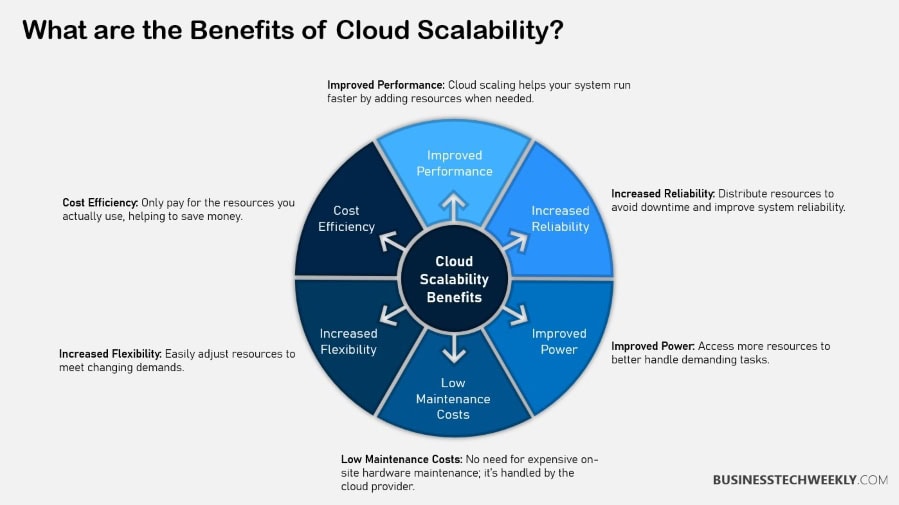What is Cloud Scalability? How You Can Benefit from It

With cloud scalability, you can automatically scale resources up or down according to usage. It has become an essential tool that drives dynamic computing through increased flexibility and efficiency.
Vertical and horizontal scaling have their own unique benefits with each approach has its own set of advantages and drawbacks.
Implementing cloud management tools, such as Kubernetes, can help with the scalability aspect.
Knowing how these concepts work enables you to start to optimize your operations and truly leverage technology to help you grow.
On this page:
What is Cloud Scalability?
1. Define Cloud Scalability
Cloud scalability allows a cloud environment to manage surges in workloads by easily scaling up infrastructure.
This helps you save costs while ensuring your application runs efficiently at any level of demand. When your business experiences a sudden increase in demand, this is when truly scalable systems kick in.
They allow you to rapidly scale up the computing resources that are dedicated to your application.
This flexibility is important, as it helps your systems perform while minimizing downtime or interruption of service. Add nodes or resources to be able to switch and maintain operations without interruption.
Beyond these advantages, scalability is integral to improving system efficiency. When the demand on workloads fluctuates, flexibility to scale up or down is key.
This method maximizes resource allocation, reduces resource redundancy and waste, and saves money.
Vertical scaling increases a server’s computing capabilities by adding additional RAM or CPU cores. This flexible approach allows you to meet increased demands without the burden of overhauling your current infrastructure.
Horizontal scaling improves computing power by increasing the number of servers or nodes. This variety of workloads also makes it ideal for applications that require the highest levels of availability.

2. Importance in Modern Computing
In today’s dynamic landscape of rapid technological advancement, cloud computing scalability becomes a pivotal element for organizations striving to maintain a competitive edge.
It allows for fast expansion and flexibility to be agile with evolving customer needs, ensuring that you can keep your services up and running while meeting customer expectations.
Smart, scalable cloud infrastructure is most impressive when it proactively scales resources for heavy-use hours, reducing service interruption and ensuring a quality, speedy experience.
This dynamic, on-demand adaptability is the key to the most innovative and agile companies that are driving innovation and long-term success.
Scalability isn’t only about keeping up with today’s demands—it’s about enabling innovation and growth.
With these efficient scalable systems, IT teams are free to support more projects and systems with ease. They build a consistent data model, which simplifies processes and increases efficiency.
As your business grows, scalable solutions ensure that you can meet increasing demands without compromising service quality or incurring unnecessary expenses.
As of 2024, 96% of companies utilize at least one public cloud service, with half of their workloads managed on public clouds.
3. Cloud Scalability vs. Elasticity
|
Aspect |
Cloud Scalability |
Cloud Elasticity |
|---|---|---|
|
Definition |
Capacity to add resources to handle increased workloads |
Automatic adjustment of resources to match demand |
|
Use Cases |
Long-term growth, predictable increases in demand |
Short-term spikes, unpredictable demand fluctuations |
|
Benefits |
Stable performance, cost efficiency |
Immediate resource availability, cost control |
Scalability focuses on providing additional resources and capacity to support future growth.
In contrast, elasticity is about dynamically scaling resources up and down to meet immediate demand changes.
Both ideas are key to getting the most out of the cloud, especially in conditions with volatile demand.
This makes it easy for you to rapidly increase or decrease resources in order to adapt to your dynamic business requirements.
This kind of flexibility is what allows your application to stay responsive, even when your customers demand diversity in how they use your application.

Types of Cloud Scalability
In cloud computing, understanding the various types of cloud scalability is critical for effectively managing resources.
The three main types—vertical, horizontal, and hybrid scalability—offer distinct solutions to address varying workload demands and optimize cloud infrastructure for peak and trough business requirements.
Vertical Scaling Overview
Vertical scaling, known as “scaling up,” is the process of adding power to resources you already have to improve their performance.
With vertical scaling, you increase your system’s performance by adding hardware resources, such as improving your CPU and memory.
Or, increase your storage capacity on the fly by inserting hard disks or solid state disks.
If your application suddenly requires more processing power you can scale up by increasing the power of one of your servers. Just increase its RAM or CPU cores to improve its performance.
In cloud environments, vertical scaling improves performance immediately.
It’s the perfect option for applications that have steady, expected growth. Yet, it could be limited by the physical capabilities of one server.
Horizontal Scaling Overview
Horizontal scaling, referred to as “scaling out,” involves adding more instances to increase processing power.
This type of scalability is ideal for stateless applications that require high availability.
It is able to sustain a very high number of simultaneous connections.
Horizontal scaling is when more servers are added to handle the load of a web application. You can also scale up your current cluster by adding virtual machines, containers, or other resources.
This method of cloud scalability also keeps workloads evenly distributed, providing strong performance even at the busiest times.
With horizontal scaling, you also gain one of its primary benefits—elasticity. That means you can scale cloud services up or down at lightning speed, a game-changer for elastic workloads like those found in the world of streaming services.
Diagonal Scaling Overview
Diagonal scaling, which is a blend of vertical and horizontal tactics, provides agility to handle different workload needs and helps balance resource use with demand.
For example, you can scale up your existing servers’ capacity while also scaling out by adding new instances.
This approach provides the most flexibility, which is critical for any rapidly growing company that must be able to pivot easily to meet new demands.
Combining vertical and horizontal scaling produces a more potent vertical/horizontal scaling strategy.
It increases the servers, storage, and networking resources available to maintain top performance and resource efficiency at times of peak demand and activity.

Benefits of Cloud Scalability
Among these features, cloud scalability proves to be the most critical for companies looking to leverage technology’s complete capabilities.
Among its greatest benefits are saving money, improving performance, and increasing redundancy. When you adopt these solutions, new opportunities to save money on technology become available.
Since you can dynamically scale resources up and down to meet demand, you can truly stop over-provisioning.
Leveraging tools such as nOps provides you with fantastic visibility into your cloud infrastructure. Armed with this insight, you can make better informed decisions, saving you up to 30% in unnecessary costs.
The financial benefits go even deeper, as scalable solutions provide the flexibility to adjust to changing workloads, keeping operating costs in line.
Achieving Cost Efficiency
To maintain cost efficiency, you can take advantage of cloud scalability by scaling resources up or down based on real-time needs.
By only scaling when you need to, you’ll never over-provision and pay for excess capacity, getting the most out of your resources.
Vertical scalability is a perfect case in point, letting you boost performance of current assets and reduce wasted spend in the process.
Importantly, cloud scalability also makes sure that no resources are wasted when traffic is at its lowest, saving you money without sacrificing performance.
Enhancing Performance
When it comes to increasing the performance of systems — especially when faced with high workloads — cloud scalability is key.
By distributing workloads across a variety of resources, you gain more powerful processing capabilities, and you gain systems resilience.
Resource allocation optimization is vital to maintaining high performance levels, and effective scaling strategies can lead to significant performance boosts.
Businesses, for example, can enhance their operations by scaling resources up during peak demand, ensuring smooth and efficient performance.
84% of companies employ at least one private cloud, and on average, they run 32% of their workloads in private cloud environments, indicating a trend toward hybrid cloud solutions that offer scalability and flexibility.
Boosting Reliability and Flexibility
System reliability is improved by providing always-on availability. This adaptability of scalable cloud environments helps your business meet future challenges and opportunities without missing a beat.
Additionally, redundancy in scaling strategies further reduces risks of failure, offering fault tolerance and rapid recovery capabilities to reduce downtime. This redundancy means that even in the event of a failure, service disruption is limited to a minimum.
Simplifying Deployment Processes
Cloud scalability makes it easier to deploy new applications and services with reduced operational overhead.
With automated scaling features, the process is less likely to require manual input, where mistakes are more likely.
This advantage is largely due to the benefits of simplified deployment, which also speeds time-to-market for new solutions, delivering an even greater competitive edge.
These optimized cloud services allow you to activate from anywhere in just minutes.
This increased efficiency gives you the competitive edge to keep up with the rapid movement of today’s market.

Strategies to Achieve Cloud Scalability
In order to successfully obtain cloud scalability, organizations need a mix of strategies. These strategies are what allow them to conquer and continuously scale their cloud environments.
These strategies are key to both meeting the needs of the business and matching the demands of workload as they ebb and flow.
Here’s a bullet list of effective strategies for achieving cloud scalability:
- Auto-scaling
- Load balancing
- Containerization
- Infrastructure as Code (IaC)
1. Implement Auto-Scaling Features
Auto-scaling is key to utilizing cloud resources dynamically and efficiently. It allows systems to dynamically redistribute resources based on real-time demand.
This method automatically increases or decreases the number of available resources to align with fluctuating load requirements. It helps avoid over-provisioning resources while guaranteeing performance during busy-hour peaks.
Implementing auto-scaling features goes a long way towards both saving costs and improving performance.
For example, if a virtual machine requires additional computing power, with scalability you can quickly add external CPU, storage or memory.
This strategic shift also allows for increased operational efficiency.
2. Utilize Load Balancing Techniques
Load balancing works to prevent system bottlenecks, ensuring that a lack of instance responsiveness does not impact the user experience.
By preventing any one server from getting overloaded, load balancing improves the performance of your entire application.
In particular, modern load balancers, like those built-in to cloud platforms, make scaling automatic and invisible.
They make sure highly optimized cloud services are deployed, available, and functioning from anywhere in minutes.
3. Apply Containerization Methods
By enabling applications to take advantage of horizontal scaling, containerization can make a big impact on resource management efficiency.
Technologies such as Docker and Kubernetes provide strong solutions to the orchestration of container-based environments.
Kubernetes is an open-source container orchestration tool. It orchestrates, schedules, and runs those containerized applications, making sure they run at their best and are always available.
Optimized resource usage is therefore critical to maximizing the use of resources in cloud environments.
4. Leverage Infrastructure as Code (IaC)
Infrastructure as Code (IaC) automates the management of cloud infrastructure. It provides confidence through the automation of consistent, repeatable deployments making it easier to scale solutions across a large enterprise.
By simplifying the processes involved in scaling and minimizing the complexity of infrastructure management, IaC helps organizations better map their infrastructure management to their business goals.
HPE Ezmeral Data Fabric provides a comprehensive, unified data architecture that provides a single common data layer for all applications. This architecture greatly enhances scalability and operational efficiency.

Tools for Effective Cloud Scalability
In the journey toward overall effective cloud scalability, deciding on the right tools is a critical first step. These tools enable organizations to soar to new heights. They also ensure that the scaling process is completely seamless, and highly cost-effective.
Continuously monitor, optimize, and automate your cloud infrastructure. This mindset helps you develop a flexible environment that can better meet your business’s changing requirements over time.
Cloud Management Platforms
Cloud management platforms are essential for managing and controlling cloud resources and services.
This gives users a clear view of their entire cloud infrastructure, helping them understand how their resources are being used and where improvements can be made.
Centralized management gives you the control you need to maximize the value of your cloud resources.
It maximizes your use of them, minimizes waste and helps you scale effectively. The biggest advantage of these platforms is that they do it all—in one complete solution.
Consider HPE Ezmeral Data Fabric, for instance. It provides a consistent data fabric that extends across your enterprise so you can store and manage data wherever it resides.
Monitoring and Optimization Tools
To make cloud scalability easier, a number of monitoring and optimization tools provide valuable assistance. Some key tools include:
- Provides visibility into cloud spending while maximizing savings, particularly for Kubernetes environments, with an average saving of 68% through machine learning and automation.
- Offers a highly scalable, software-defined solution for data storage, management, and motion.
These intelligent tools monitor performance metrics, resource utilization, and workload demands, providing 24/7 monitoring and real-time scaling adjustments.
Continuous monitoring is key because it lets you catch and fix scaling issues before they ever become an issue for performance.
72% of companies spend over $1.2 million annually on cloud services, with 36% exceeding $12 million, highlighting the significant financial commitment to scalable cloud infrastructure.
Automation and Orchestration Solutions
Automation and orchestration solutions are foundational tools to help realize cloud scalability.
Open-source tools such as Kubernetes help automate deployment, scaling and management of containerized applications, reducing the complexity of managing a sprawling application architecture.
This orchestration not only makes resource management easier, but it improves overall operational efficiency by automating processes to scale up and down.
Infrastructure as Code (IaC) is a key principle to making your scalability more effective – and easier.
This practice leads to more efficient and streamlined resource provisioning.
With automation as the backbone of your scaling strategies, you’ll set your infrastructure up to proactively and efficiently serve dynamic workload demands.
Key Points to Note
Cloud scalability is a game changer for businesses. You get the flexibility to easily scale up to meet peak periods or scale back when demand decreases.
- With cloud scalability, businesses can scale their resources in line with increasing workloads. By quickly adding resources, they are able to maintain performance levels and avoid downtime.
- It’s important to clarify the difference between cloud scalability and elasticity. While scalability is about adding resources up front, elasticity is about automatically scaling the resources you have retroactively.
- They seamlessly serve to accommodate fluctuating workload peaks, improve performance, and maintain mission-critical operations.
- Realizing cloud scalability isn’t just a competitive advantage—it’s a necessity. It drives continuous innovation, enables a pivot to dynamic customer expectations, and delivers future-proof viability.
- For cloud scalability that’s customized to your organization’s needs, adopt smart practices. Ensure you adopt practices like auto-scaling, load balancing, containerization and Infrastructure as Code.
- Having the right tools certainly helps. Cloud management platforms and automation solutions allow you to scale, optimize, and monitor your cloud resources with ease.
Frequently Asked Questions
What is cloud scalability?
Cloud scalability, a vital aspect of cloud computing, enables enterprises to effectively manage changing workload demands while optimizing performance and reducing cloud costs.
What are the types of cloud scalability?
There are three main types of scalability: vertical, horizontal, and diagonal.
Vertical scalability involves adding more power to existing machines, while horizontal scalability focuses on deploying additional servers to address workload demands.
Diagonal scalability combines these two approaches for optimal performance.
What are the benefits of cloud scalability?
In addition to significant cost savings, cloud computing scalability provides increased performance and flexibility, allowing organizations to respond to fluctuating needs faster while only paying for the optimal scalability they require.
How can businesses achieve cloud scalability?
Businesses can achieve cloud computing scalability by selecting the right cloud service provider, optimizing their cloud architecture, and utilizing auto-scaling strategies that adjust resources automatically based on workload demand.
What tools help with cloud scalability?
AWS Auto Scaling, Microsoft Azure’s Virtual Machine Scale Sets, and Google Cloud’s Compute Engine provide powerful servers with automated scaling capabilities.
These scalable cloud solutions give enterprises the visibility and control needed to meet their cloud computing scalability needs.
Why is cloud scalability important for startups?
For startups, cloud computing scalability is a godsend, reducing upfront costs and allowing you to scale applications at the speed of your success.
It also provides operational flexibility to achieve optimal scalability without a large capital expenditure.
Can cloud scalability improve customer experience?
Cloud computing scalability ensures your systems are operating at peak performance when your audience is most active, providing a seamless user experience while minimizing downtime and guaranteeing quick response times.

